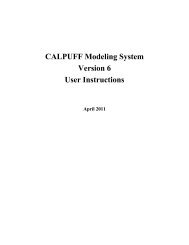Volume 1 - The Atmospheric Studies Group at TRC
Volume 1 - The Atmospheric Studies Group at TRC
Volume 1 - The Atmospheric Studies Group at TRC
Create successful ePaper yourself
Turn your PDF publications into a flip-book with our unique Google optimized e-Paper software.
D<strong>at</strong>um: NAS-C (North American 1927)<br />
SW Corner Coordin<strong>at</strong>es (km): (708.1, 3864.1)<br />
Number of cells (nx,ny): (100,130)<br />
Cell Size (km): 0.200<br />
<strong>The</strong> CALMET preprocessors TERREL, CTGPROC, and MAKEGEO are applied to<br />
convert the geophysical d<strong>at</strong>asets to this modeling grid, cre<strong>at</strong>ing the CALMET<br />
GEO.DAT file.<br />
Coordin<strong>at</strong>e transform<strong>at</strong>ions are applied to the source and receptor loc<strong>at</strong>ions listed in<br />
the OCD4 model runs in order to register these fe<strong>at</strong>ures to land use and terrain d<strong>at</strong>a in<br />
the GEO.DAT file. <strong>The</strong> OCD4 d<strong>at</strong>aset uses a grid system th<strong>at</strong> is referenced to a local<br />
l<strong>at</strong>itude/longitude grid, as depicted in the OCD4 Users Guide (Dicristofaro and<br />
Hanna, 1989). <strong>The</strong>se (x,y) coordin<strong>at</strong>es are scaled to l<strong>at</strong>itude/longitude by m<strong>at</strong>ching<br />
sampler loc<strong>at</strong>ion (x,y) coordin<strong>at</strong>es with their position on the site map. <strong>The</strong><br />
l<strong>at</strong>itude/longitude positions obtained in this way are then transformed to the UTM<br />
(Zone 10N) map projection in d<strong>at</strong>um NAS-C.<br />
<strong>The</strong> resulting map of the experiment region is shown in Figure 4-3. <strong>The</strong> beach area<br />
where nearly all of the coastline samplers are loc<strong>at</strong>ed falls into the barren<br />
classific<strong>at</strong>ion, and this is consistent with area photographs. Significant terrain<br />
fe<strong>at</strong>ures do not influence these sampler loc<strong>at</strong>ions, and probably do not affect the<br />
secondary samplers loc<strong>at</strong>ed further inland.<br />
Source & Receptor Characteriz<strong>at</strong>ion<br />
Tracer releases are characterized as modeled in the OCD4 evalu<strong>at</strong>ion. All are<br />
modeled with downwash, using the bo<strong>at</strong> dimensions as a solid building with the<br />
length perpendicular to the wind. A minimal exit velocity is used to remove any<br />
momentum rise.<br />
All sampler loc<strong>at</strong>ions are used as receptors, but additional ones are added to increase<br />
the density of receptor spacing along the two arcs in each experiment. Intermedi<strong>at</strong>e<br />
receptors are placed <strong>at</strong> approxim<strong>at</strong>ely 100m intervals along the shoreline arc and<br />
250m along the inland arc, with elev<strong>at</strong>ions interpol<strong>at</strong>ed from the actual sampler<br />
elev<strong>at</strong>ions. Two hundred forty-one (241) receptors are used in all.<br />
Final Report Vol.1 39







